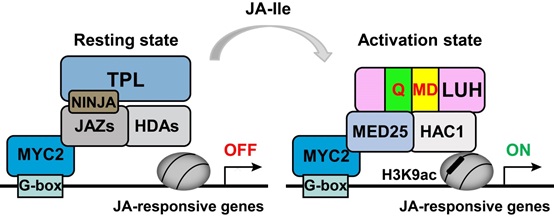The lipid-derived hormone jasmonate (JA) regulates plant immunity and adaptive growth by triggering a genome-wide transcriptional programming that is largely regulated by the master transcription factor MYC2. Although the mechanisms involved in transcriptional repression and hormone perception are well known, the molecular mechanism of hormone-dependent activation of MYC2 is less studied.
Groucho (Gro)/Tup1 family proteins are emerging as a fundamentally important class of transcriptional coregulators that are conserved in eukaryotic cells. Compared to their prominent function in transcriptional repression, little is known regarding the mechanism and biological implications of this family in transcriptional activation.
Recently, the team led by Prof. LI Chuanyou at the Institute of Genetics and Developmental Biology, Chinese Academy of Sciences, uncovered a function mechanism of the Arabidopsis Gro/Tup1 family member LEUNIG_HOMOLOG (LUH) in activating MYC2-regulated transcription of JA-responsive genes.
LI’s team has long been investigating the transcription regulation of JA signaling. Their previous work found that the Arabidopsis Mediator subunit MED25 interacts with MYC2, and recruits RNA polymerase II (Pol II) to MYC2 target promoters. They also found that MED25 physically interacts with HISTONE ACETYLTRANSFERASE OF THE CBP FAMILY1 (HAC1), which promotes JA-responsive gene expression by acetylating Lys-9 of histone H3 (H3K9ac) of MYC2 targets.
In the recent study, they found that LUH is physically recruited to MYC2 target promoters by MED25. LUH then links MYC2 with the enzymatically active histone acetyltransferase HAC1 to activate MYC2 targets through the imposition of transcriptionally active histone H3K9 acetylation. These results revealed that LUH, in cooperation with MED25 and HAC1 through its distinct domains, imposes a selective advantage on MYC2-dependent transcription of jasmonate-responsive genes.
In the context that TOPLESS, another member of the plant Gro/Tup1 family, represses MYC2-dependent gene expression in the resting stage, these study revealed that different members of the plant Gro/Tup1 family play opposite roles in regulating the same signaling pathway through distinct mechanisms.
These results extend our understanding on the action mechanisms of the evolutionarily conserved Gro/Tup1 family proteins.
This study was supported by grants from Chinese Academy of Sciences, the Ministry of Science and Technology of China, the National Natural Science Foundation of China and the Youth Innovation Promotion Association of CAS.
The paper entitled “LEUNIG_HOMOLOG Mediates MYC2-Dependent Transcriptional Activation in Cooperation with the Coactivators HAC1 and MED25” has been published online in
The Plant Cell (
DOI: 10.1105/tpc.19.00115).
Figure. Proposed model of LUH in the transcriptional activation of jasmonate signaling. (Image by IGDB)
Contact:
Mr. QI Lei
Institute of Genetics and Developmental Biology of the Chinese Academy of Sciences
 Figure. Proposed model of LUH in the transcriptional activation of jasmonate signaling. (Image by IGDB)Contact:Mr. QI LeiInstitute of Genetics and Developmental Biology of the Chinese Academy of SciencesEmail: lqi@genetics.ac.cn
Figure. Proposed model of LUH in the transcriptional activation of jasmonate signaling. (Image by IGDB)Contact:Mr. QI LeiInstitute of Genetics and Developmental Biology of the Chinese Academy of SciencesEmail: lqi@genetics.ac.cn CAS
CAS
 中文
中文




.png)
